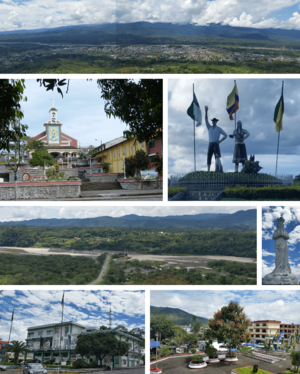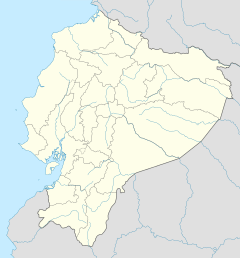Macas (city) facts for kids
Quick facts for kids
Macas
|
||
|---|---|---|
|
City
|
||
| Macas | ||

From top, left to right: Panoramic view of the city, Cathedral of Our Lady Purest of Macas, monument to the inhabitants of Macas, Bridge of the Upano River, monument to Our Lady Purest of Macas in the viewpoint of Quílamo hill, City hall of Morona and Civic Park of Macas.
|
||
|
||
| Nickname(s):
Esmeralda Oriental (Emerald of the East)
|
||
| Country | Ecuador | |
| Province | Morona Santiago | |
| Canton | Morona Canton | |
| Sevilla del Oro | mid-1500s | |
| Government | ||
| • Type | Mayor and council | |
| Area | ||
| • City | 15.73 km2 (6.07 sq mi) | |
| Elevation | 1,050 m (3,445 ft) | |
| Population
(2022 census)
|
||
| • City | 22,398 | |
| • Density | 1,423.9/km2 (3,687.9/sq mi) | |
| • Demonym | Macabeo(-a) | |
| Time zone | UTC-5 (ECT) | |
| Climate | Af | |
Macas is the capital city of the Morona Santiago province in southeastern Ecuador. It is also the main city of the Morona county. People call Macas the "Emerald of the East." This is because it is located east of the Andes mountains.
Macas sits in the Upano Valley, right next to the Upano river. About 22,398 people live in the city. Long ago, during Spanish rule, Macas was a key starting point. It helped Spanish explorers and settlers move into the Amazon region. Today, local indigenous groups often use cities like Macas. They hold important meetings and organize their political groups here. Macas is also becoming a popular place for tourists.
The city is a big center for farming and raising animals. It also serves as a transport hub for smaller jungle communities. Farmers here grow crops like yuca, sugarcane, papaya, coffee, and bananas. In recent years, Macas has started to attract tourists. Visitors can enjoy jungle treks, trips to indigenous villages, and exciting sports like rafting. You can reach Macas by road from Puyo to the north and Riobamba to the west.
History of Macas
The name Macas comes from the Macas Indians. These people are thought to have lived in a large part of what is now the Ecuadorian Amazon. The area was first founded in 1538 by Spanish captain Juan Villanueva Maldonado. He named it 'Sevilla del Oro'.
Later, the city was renamed 'Macas' and refounded in 1599. For many years, Macas was on the edge of the Chimborazo province. In 1929, Macas officially became the capital of the Morona Santiago province.
Culture and People
Beyond Macas, you can find the lands of the Shuar and Macabea cultures. These are indigenous peoples who have lived in this region for hundreds of years. Macas is a great place to start if you want to learn about these cultures. It's usually best to explore with a local guide.
In the city itself, many people create handicrafts and art. These local artists help the economy of Macas.
The food in Macas often includes a lot of fish and chicken. The city has many restaurants. You can find everything from seafood to Chinese food.
See also
 In Spanish: Macas (Ecuador) para niños
In Spanish: Macas (Ecuador) para niños



